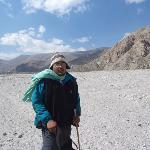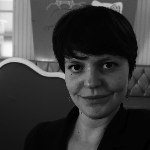
Climate Communication by The Thin Page
 Sardar Mohazzam Apr 24, 2014 06:21 |
It is a great proposal. However, a little detail on the existing telecommunication infrastructure, and how accessible the telecommunication network is in disaster prone areas can clarify the feasibility to the audience.
|
 Deep Prakash Ayadi Apr 28, 2014 08:39 | Proposal contributor
Thank you for your comment, Mohazzam. We will surely add value and incorporate your comment.
|
 Ricardo Jimenez May 19, 2014 01:42 |
Hello
I agree with mohazzam, it's indeed a good proposal, however, I think you should clarify some aspects:
1. Capacity building needs access to population and ressources. You need to be sure people understand what climate change risk related imply and how to drive adapation initiatives.
2. It should not be only about access to information, because as communities will learn how to use data, they will need ressources to implement adaptation measures. This might include leaving their homeland.
3. Adaption is one of the main aspects to drive climate change a global scale, specially in regions with high rates of poverty where even with a lot of information they will still be vulnerable, so it would be great to propose some follow up action, in order to help the ommunities with the real adaption.
Look forward to hearing back from you.
Regards,
|
 Khalid Md Bahauddin Jun 1, 2014 03:39 |
No doubt the concept and idea of this proposal is time worthy but following things need to be clarified.
1. How many people use internet/ mobile technology in remote areas/ disaster prone areas and coverage of mobile network and must clarify the strength of mobile network for smooth implementation of this project.
2. How you will select and what will be the criteria to select community facilitator, CF and how S/he will disseminate the information.
3. What about the implication of this technology after disaster occurred?
4. Who will bear the mobile credit cost?
5. Community should have contingency plan, what will be happened with VDC after phase out of project, clarify the sustainability of your project.
6. Location of the mobile user can be identified by two basic approaches (Heikki, 2001) which methods you will be applied?
• One is through the mobile network signal system where signals send by the mobile phone system to its base and
• Another is through using integrated Global Positioning System (GPS) with the mobile phone receiver, an additional hardware that takes care of location functions.
Thank you
Khalid Md. Bahauddin
|
 Michelle Tigchelaar Jun 11, 2014 08:31 |
I agree with the commenters above that this is in principle a good proposal, but it needs some clarifications. In particular it might be useful to elaborate on what kind of disaster information this application will collect, how this information will be linked to climate change projections for the regions, and how you expect community members to act on this information. In the summary of the proposal, perhaps you could make it clear that your proposal concerns the area of Nepal, and give some examples of how climate change is expected to impact the region.
Thank you.
|
 Michael Brown Jun 18, 2014 02:49 |
This is a good proposal, well-written and thought out, that I think could be made excellent. The other catalysts above have made very good suggestions that I hope you will respond to in your final version. A few additional suggestions/comments:
1. It seems that the 'deliverable' is a mobile application. The literature review and stakeholder engagement are some of the methods you will use in the process. I would make the distinction a little more clear in the 'proposed actions' section.
2. You don't have to convince me of the merits of stakeholder engagement and community empowerment, but I think articulating why this is important (or critical!) to success will go a long way in telling a compelling story. Some explanation of how you will engage would also help.
3. I am glad to see you are based in Kathmandu. You should elaborate on your connection to the community of interest (Nepal) and why you might be better-situated to deliver this proposal than a group from a different country.
4. Some explanation of the type and severity of disasters in Nepal would be useful for context.
5. As noted above by mohazzam, some background on the existing telecom infrastructure in Nepal is critical. Foreign readers may not know anything about it and could assume that lack of infrastructure would automatically preclude this approach.
6. I don't have first-hand experience with app development, but be careful not to underestimate the time and level of effort required to get it to work properly. Robust performance would be a requirement of this type of application.
7. Your budget seems like good value-for-money, but again consider the time and level of effort requirement. As well, some consideration of the relative levels of funding internally (staff, office, travel costs) and stakeholder funding ('Development and Enabling Cost', I assume).
Good luck,
Mike
|
 Angélica Lara P.r. Jun 19, 2014 10:19 |
Hi,
Thanks for your submission, this is a great proposal, but i have to comments that maybe could help you.
The first one, it's necessary to promote capacity building in the communities about natural disaster risks and the initiatives to drive adaptation. Also is important teach them how to use that information.
Best regards
|
 Carolina Collaro Jun 20, 2014 05:02 |
Hi,
it is a viable proposition even if not new, at least in Europe. Here you can see many applications of Web GIS, which allows citizens to access information and participating in the DRR. The problem is how to implement the climate change, how to integrate the projections on climate change, from what sources of data. Not all European countries and also in the world, have a National plan to implement adaptation that says data on climate change. And then this is a problem of governance, which is also reflected here in this proposal, and the use of the technology choice, not the web-gis but the mobile technology. Of course, You could trait only one kind of risk, without climate change, avoiding excessive uncertainty. Then, please, specify what kind of risks you are referring to, specifically and what kind of data do you foresee to utilize.Regards
|
 Deep Prakash Ayadi Jul 9, 2014 04:51 | Proposal contributor
Dear Andres
Thank for your constructive comments and suggestions.
The proposed project will take following actions,
1. Understanding the climate change at the community level is the key and that can only leads to any further adaptation activities. So, climate awareness campaign will be organized in order to achieve this goal.
2. This project aims to access to information on disaster. Further resource and actions are beyond the scope at the time and can be accommodated in next stage of project extension.
Thank You
|
 Deep Prakash Ayadi Jul 9, 2014 04:54 | Proposal contributor
Dear Khalid
Thank you for your kind words. Please find my comments and opinion about your inquiries as below (#);
1. How many people use internet/ mobile technology in remote areas/ disaster prone areas and coverage of mobile network and must clarify the strength of mobile network for smooth implementation of this project.
# In Nepal, the telecommunication coverage has reached in most of the section of the country and outreach is increasing at very fast rate. Although, mobile internet connectivity is not stable in some of the remote areas.
2. How you will select and what will be the criteria to select community facilitator, CF and how S/he will disseminate the information.
# A part of this inquiry is already addressed in revised proposal.
3. What about the implication of this technology after disaster occurred?
# If you could explain bit more on this.
4. Who will bear the mobile credit cost?
# Project will take care of the mobile cost for piloting. Community users have to all the cost of mobile.
5. Community should have contingency plan, what will be happened with VDC after phase out of project, clarify the sustainability of your project.
# Absolutely, sustainability is the key for success of this project. The key steps are as follows; Leveraging the idea and approaching for further support through other stakeholders, Continuous improvement in features, content and layout, Making it applicable for wider population (not only limited to Nepal) through continuous amendment and field verification, Putting a market price for its sell.
Similarly, LAPA framework has one of key component of LAPA integration into district level planning and monitoring and evaluation of activities. Mobile application could be the one of the major component for monitoring and evaluation of LAPA implementation. So, project will take/lobby the one-step-ahead approach to integrate this into local level (VDC) planning for its sustainable going.
6. Location of the mobile user can be identified by two basic approaches (Heikki, 2001) which methods you will be applied?
• One is through the mobile network signal system where signals send by the mobile phone system to its base and
• Another is through using integrated Global Positioning System (GPS) with the mobile phone receiver, an additional hardware that takes care of location functions.
# Second method will be applied to track the position.
Thank you
|
 Deep Prakash Ayadi Jul 9, 2014 04:17 | Proposal contributor
Hello MT
We will surely add some points on summary section of the proposal.
The mobile based application will collect, recently happened disaster events, progress on mitigation and adaptation and community based disaster risk reduction planning.
Thank You
|
 Deep Prakash Ayadi Jul 9, 2014 04:08 | Proposal contributor
Dear Mike,
Your kind suggestions is appreciative.
We are working on proposal and made a some amendments by the end of this week.
Thank You
|
 Deep Prakash Ayadi Jul 9, 2014 04:15 | Proposal contributor
Hi Angelica
I agree with you and one of the objectives of this project is to teach the community and update the recent disaster information to act on it to mitigate the disaster.
Thank You
|
 Deep Prakash Ayadi Jul 9, 2014 04:05 | Proposal contributor
Hello carolinacollaro
The project foresee to utilize the disaster data from Ministry of Home Affairs, Government of Nepal. Similarly, Government of Nepal with development partners , Local Adaptation Plan of Action (LAPA) is underway the formulation and implementation in later stage, which will also generate the disaster data. These disaster information and data will be used in this mobile based application.
Thank You
|
 Agharese Lucia Ojelede Jul 9, 2014 07:23 |
Hello,
Very interesting proposal but there are some gaps as follows:
Implementing a technology based project in remote areas is challenging and not easily acceptable.
Other factors can affect implementation such as educational level of people, access to electricity,understanding the benefits of the proposal, and use of relevant information provided to mention a few.
The training cost in the areas not included in the breakdown of project cost.
Kindly consider these highlighted areas.
Arese
|
 Sergio Pena Jul 19, 2014 01:23 |
Congratulations. This idea have been implemented in Chile. One of the main problems here are the networks to disseminate the information therefore I would recommend you to think in working with various channels, normal internet with e mail addresses, telephones and so on. At the same time it is necessary to think in terms of the legal rules to be enacted in order to promote collaborations as well as to define the minimums of technichal support.Excellent initiative.
|
 Climate Colab Aug 6, 2014 08:15 |
The Climate CoLab adaptation contest team appreciates the time that you took to submit this proposal. From the proposal, it is not entirely clear what need this application is filling, or how it is new and different from what is already being done. Please put some more time and effort into articulating what has already been done, so that you can then shape your proposal to build on what exists. The judges suggest you try to explain how your proposal will increase local adaptive responses and consider how it will aid local residents in their decision-making, planning, or daily practices. Additionally, you can explain how the types of data to be used will add to the existing knowledge that residents have about local vulnerabilities. More detail on the role of the community facilitator would also be interesting. Is this a paid position? Do they have responsibilities beyond simply entering data into the program? All in all, there is the beginning of an idea here. The judges encourage you to consider these factors and keep evolving your project. While your proposal is not advancing to the semi-finals this year, the contest team wishes you the best of luck in your endeavors and would love to see a proposal from you next year incorporating this feedback.
|